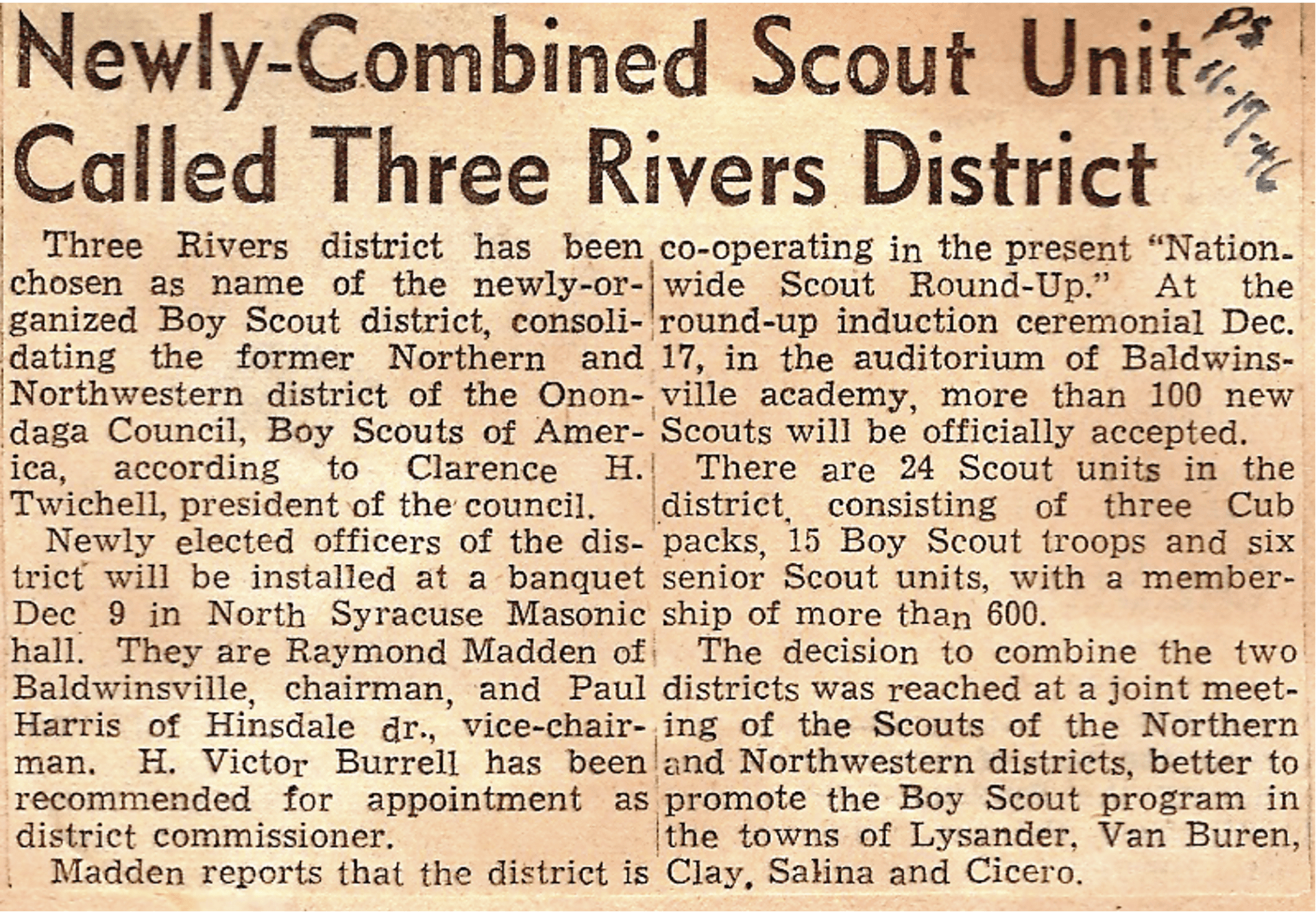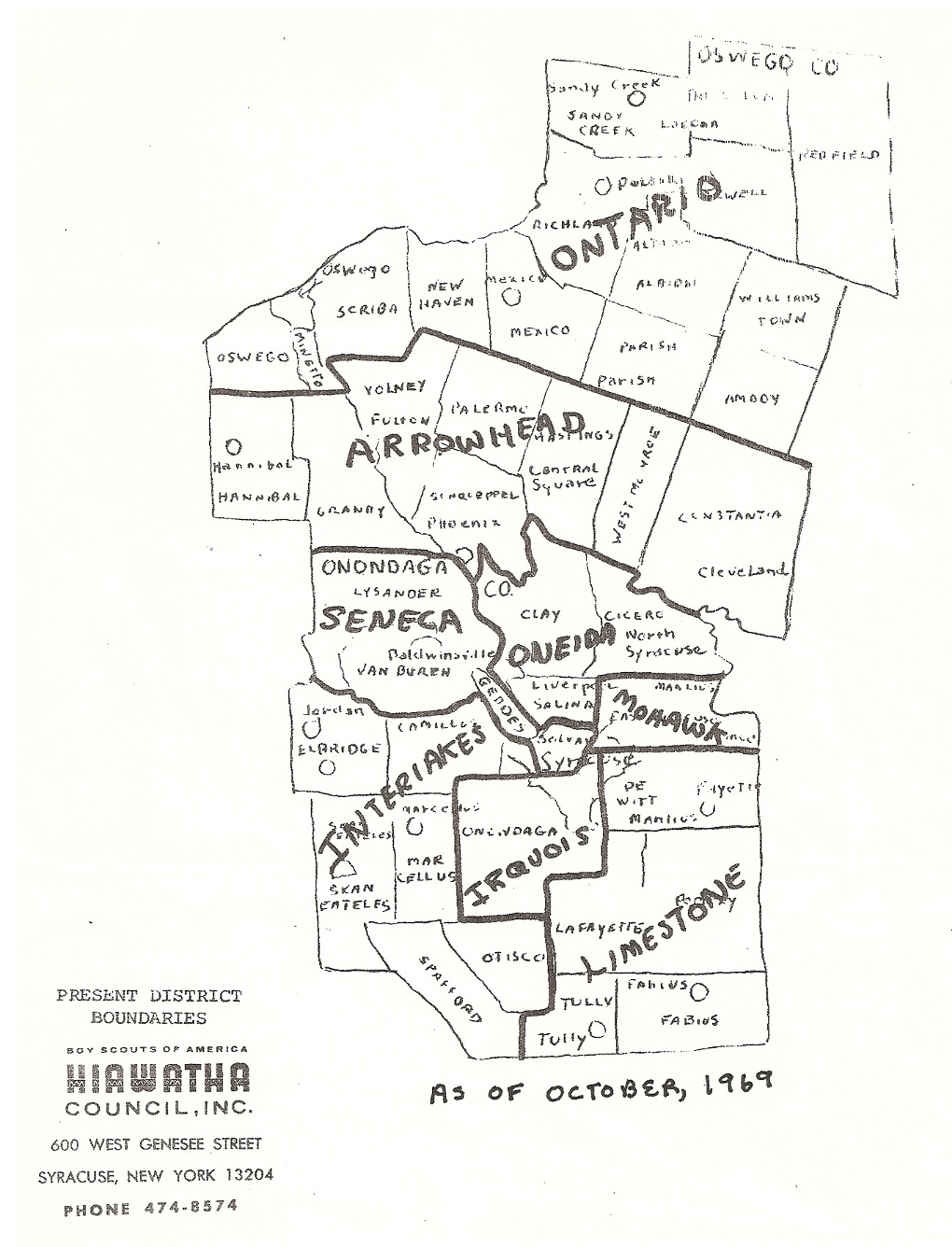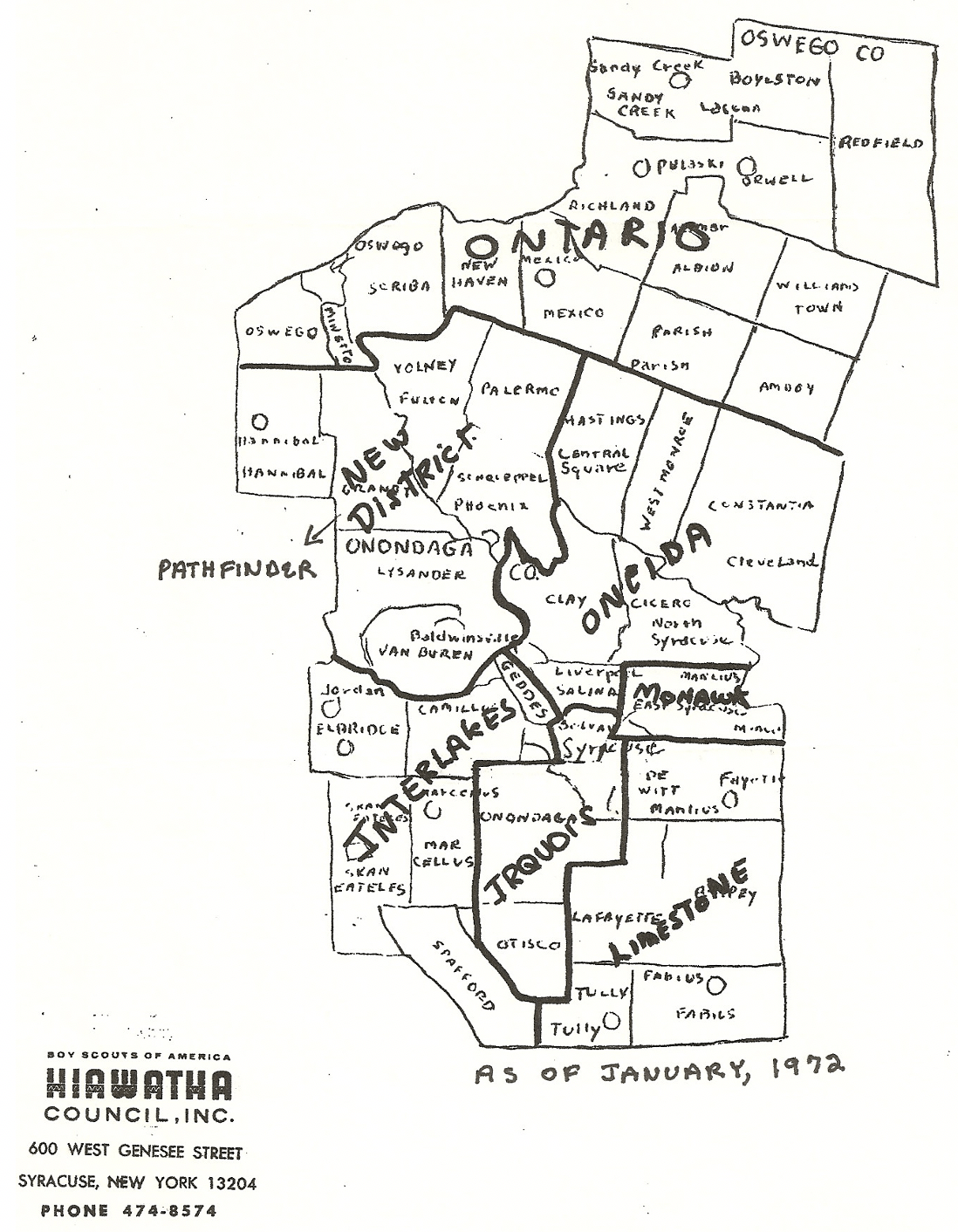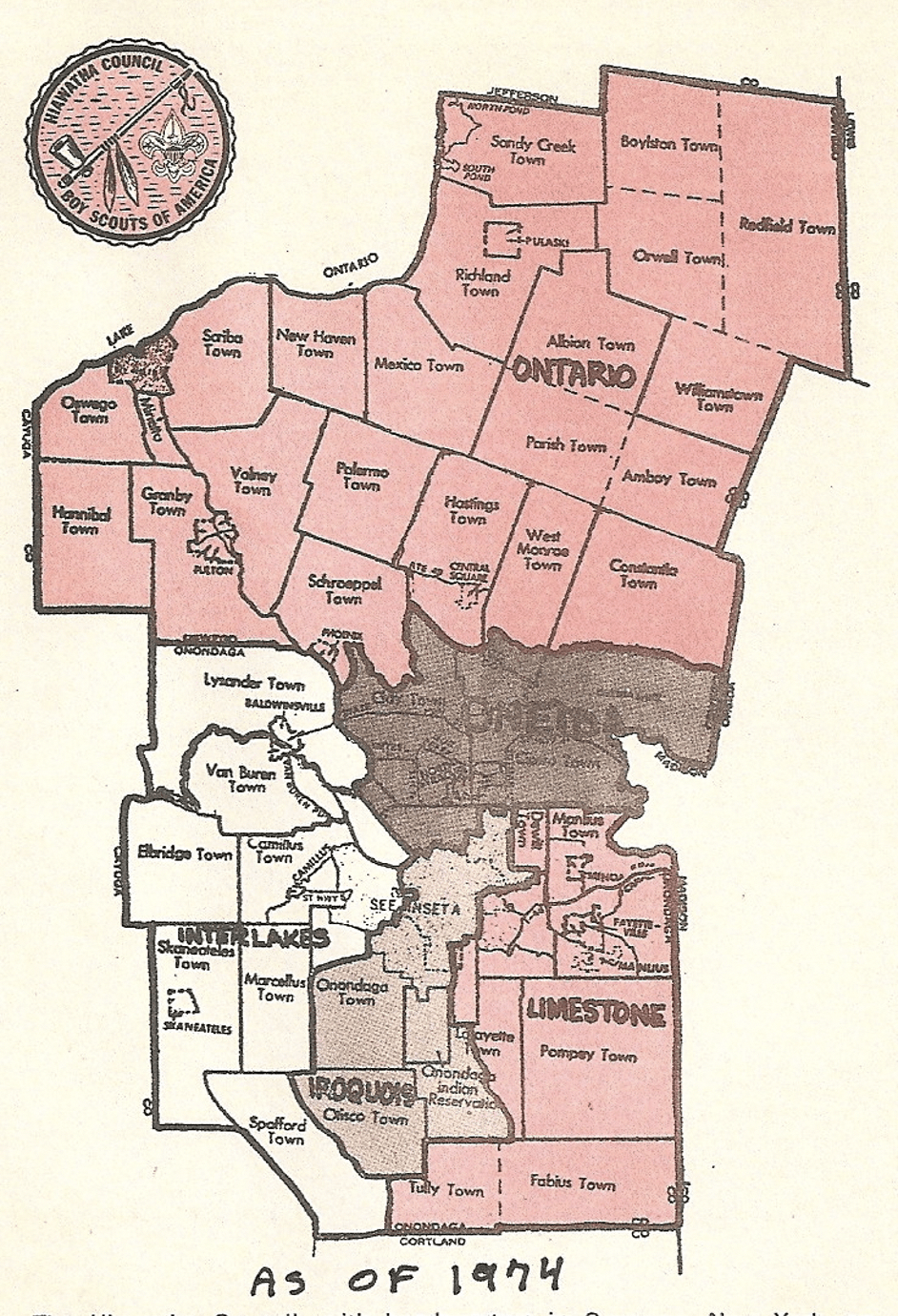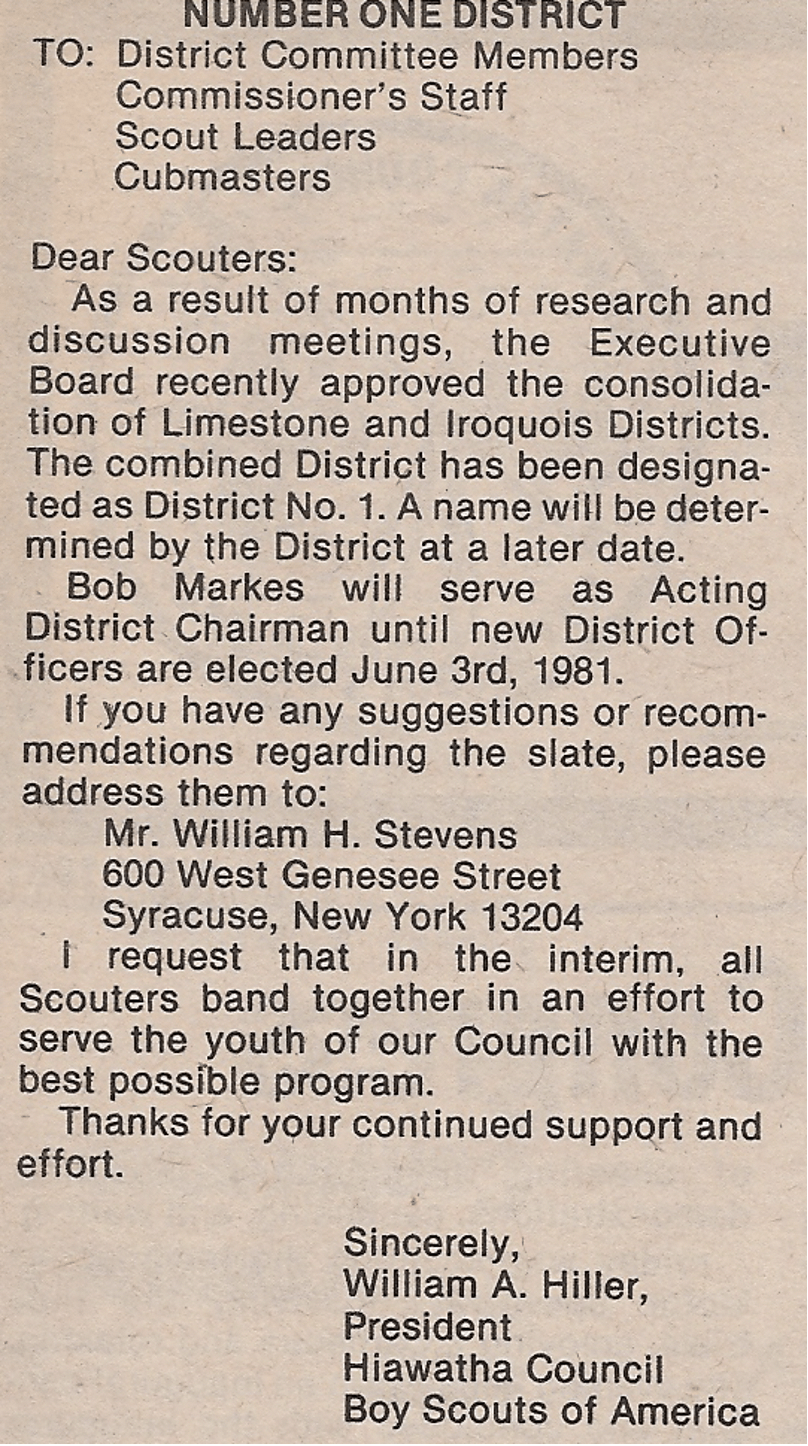COUNCIL HISTORY
1910 - 1915
During this period scout troops were being formed in the city of Syracuse. There was no formal central organization with paid professionals during this time. A Scoutmasters’ Council was formed in 1911 by a group of troops under the leadership of Charles Trump, H. Fred (Daddy) Lee, Col. William Verbeck, and Scout Commissioner A. W. Hudson.
1915 – 1921
Sometime in 1915 a decision was made to form a council under the national Boy Scouts of America. The council was named the Syracuse Council and assigned council number 390. This was one of the first councils to be formed in New York State. (See addendum for an explanation of how council numbers were assigned). The first paid Scout Executive was Arthur Rex (A.R.) Forbush. He was hired effective December 8, 1915 and resigned effective May 30, 1916. The scout office was located at 618 S.A. King Building, 220 East Genesee St, Syracuse.
The second Scout Executive was Robert S. Henderson, June 1916 to 1920.
It is difficult to determine if the there were any other paid professionals on staff during this period or what the council organization was like. There was a secretary who typed some of the correspondence I found, and in 1921 a job doing “Rural Organization work” was offered to Clarence Hunter. The job paid $200.00 a month and would involve “…all districts in rural sections of the county under my (Council Executive’s) guidance.”
Note: The Hiawatha Council History written in 1980 contains an article “History Of The Boy Scout Council”, written by Marion Harcourt. In this article it is stated that a decision to form a council was made in 1916 and that the first Scout Executive was Robert Henderson. All of my research indicates that a decision to form a council was made in 1915 and that the first Scout Executive was A. R. Forbush.
1922 – 1929
In 1922 the name of the council was changed to Onondaga County Council. The council number 390 remained. I have no explanation as yet as to why the name was changed. Henry Reichard became Scout Executive in 1920 to 1925. He was followed by George Morton 1925 to 1933. I have no been able to obtain any information regarding council organization.
1929 – 1940
In 1929, the Onondaga County Council joined with the Cortland Council and formed the Onondaga-Cortland Council representing youth in both Onondaga County and Cortland County. The council number remained 390. Cortland County was considered one of the districts in the council.
The camps of the Onondaga-Cortland Council were Camp Tioughnioga near the city of Cortland, Camp Woodland near Constantia, Rams Gulch near Jamesville and Camp Syracuse in the Adirondacks. (Camp Loyalty existed from 1918 to 1929.)
On November 14, 1939 the Cortland District petitioned the executive board to separate themselves from the Onondaga-Cortland Council effective January 1, 1940. The persons of Cortland County, led by Dr Wattenburg, Judge Ames and Fred Purchas, wanted to form their own first class council and felt they could better serve the youth of Cortland County if they were a separate council. The proposal was approved on November 29, 1939 at a special executive board meeting. Cortland County became the Tioughnioga Council
In 1931 the council was divided into 10 districts, each numbered 1 to 10, each district having a District Chairman. The districts did not have names. The staff included a Scout Executive, and professionals for Activities Organization, Rural Scouting, Cortland, Camp Woodland, Rams Gulch, and two secretaries.
During this period Leo M. Sandefur served as the Scout Executive, 1933 to 1942.
1940 – 1943
In 1940 the council was renamed Onondaga Council serving the boys who lived in Onondaga County. The council number remained 390. In 1942 Ernest Blanchard became Scout Executive, holding the post until 1958.
1943 – 1947
The Council was divided into seven districts. Each district has a District Commissioner, a volunteer who led the district; a Neighborhood Commissioner, often with more than one assistant; and an Assistant District Commissioner for Emergency Services.
- Eastern District – Fayetteville, East Syracuse
- Geddes District – Solvay, Amboy and Split Rock.
- Northern District – Mattydale, Cicero, Lyncourt, North Syracuse and Liverpool.
- Northwestern District – Baldwinsville.
- Southern District – Tully, Lafayette, South Onondaga and Onondaga Hill.
- Western District – Skaneateles and Warners.
- Syracuse District – This district covered the city of Syracuse, and was broken down into six Areas:
- Bellevue-Valley Area – All Saints Church, Roosevelt School. (The Valley was dropped after 1945, and the Area was simple known as the Bellevue Area.)
- Burnet Area – St. Patrick Church, Porter School, Syracuse State School, Polish Home on Park Ave and St. Mark’s Episcopal Church.
- Central Area – Park Street Presbyterian Church, 1st Baptist Church.
- Lemoyne Area – Grant Junior High, Webster School, LeMoyne School.
- Lincoln Area – Eastwood Baptist Church, Lincoln Junior High.
- University Area – Erwin Methodist Church, Calvary Baptist Church.
These Areas in the city of Syracuse acted as districts, as each Area conducted its own meeting and training sessions. However, they were under the umbrella of the Syracuse District, and each Area did send representatives to periodic all district meetings held at the New York Power Corporation.
1947 – 1948
In January 1947, the number of districts was reduced to four. The six districts surrounding the city of Syracuse became three Districts:
Three Rivers District – Cicero, Liverpool, Baldwinsville, Mattydale, North Syracuse and Brewerton.
Limestone District – Kirkville, Manlius, Jamesville, East Syracuse, DeWitt, Nedrow, Bridgeport, Fabius, Lyndon, Tully, Fayetteville, Pompey and Minoa.
Interlakes District – Solvay, Camillus, Fairmount, Westvale, Marcellus, Split Rock, Warners, Amber, Jordan, Lakeland, Amboy, South Onondaga and Memphis. (The district was first listed in the December 1946 Scouter as the Geddes/Western District, but this was changed to Interlakes by January 1, 1947.)
The Syracuse District remained as it was, covering the city proper divided into three areas: Burnet-Central, Lemoyne-Lincoln and Bellevue-University. Each area has a Field Scout Executive assigned to it, although at various times one Field Scout Executive covered multiple areas.
During this period there were no District Executives, rather the council employed three Field Scout Executives to manage the Districts/Areas. In November 1951, the Field Executives were renamed District Executives.
1948 – 1964
In February 1948, the number of districts was increased to six. The City of Syracuse Areas were eliminated and the city was divided into three districts. The districts outside the city remained the same. The three new districts were:
Daniel Boone District which included among others: the Dunbar Center, Porter School, Delaware Street Baptist Church, Universalist Church at the corner of Adams and South Warren Streets, Sacred Heart Church, St Mark’s Episcopal, St Sophie’s Hellenic Church, and Plymouth Congregational Church.
Kit Carson District which included among others: Lyncourt School, Our Lady of Pompeii, Le Moyne School, Holy Trinity Church, Blessed Sacrament Church and Woodlawn Methodist Church.
Buffalo Bill District which included among others: Salt Springs area, St. Andrews on Salina St, Most Holy Rosary Church, Percy Hughes School, St. James Church and School on South Salina, Edward Smith School, Lafayette Ave. Methodist Church at the corner of Lafayette and Midland.
The Scout Executives during this time were Perry S. S. Jackson (1958 – 1963 and James A. Early (1963 – 1969).
Starting in 1959, each district had its own section in the council newspaper, The Onondaga Scouter. The titles of these sections were: Daniel Boone Tree Carvings; Buffalo Bill Bull which became Buffalo Bill News; Interlakes District Doin’s; Limestone Limelight, which became the Limestone Ledger in May 1962, then became Limestone Jottings in August 1962 and the Limestone Lantern in January 1963; Kit Carson Jottings; Three Rivers Trivia, which appeared only infrequently and didn’t appear until 1962.
The Scout Executives during this period were Perry S. S. Jackson, 1958 to 1963 and James Early, 1963 to 1968
1964 – 1969
In May 1964, the Onondaga Scouter announced that there would be a realignment of the districts, to be approved at the June Council Meeting and implemented in September 1964.
I believe this reorganization was caused by a severe financial crises and the realization that the City of Syracuse did not have the youth to support three districts, that the population was moving to the suburbs. In the January 1965 Onondaga Scouter, the Council Executive wrote: “In 1964, most of our Scout Districts were without Executive Service over 50% of the year. Lack of Executive Service was due to a shortage of funds.” He went on to say that the Executive Board authorized the filling of District Executive positions for all of the districts and found other ways money would be saved and raised.
The total number of Districts remained at six, but their names and boundaries did change. It took until December of 1964 until all the names and boundaries were finalized.
The districts were now:
- Iroquois District - covered the southern part of the City of Syracuse
- Mohawk District - covered the northern part of the City of Syracuse
Seneca District –– Solvay, Onondaga, Lakeland and Baldwinsville. The district was divided into two parts: (a) Essentially a rectangular area composed of the towns of Van Buren and Lysander with the village of Baldwinsville in the center and (b) a narrow strip running southeast through the town of Geddes and the village of Solvay into the northwestern part of the city of Syracuse. This part of the city contained some "inner city".
Interlakes District – Camillus, Skaneateles, Fairmont and Elbridge.
District #5 continued the name Limestone District in November 1964 – Fayetteville, Lafayette, Jamesville, Lyndon and DeWitt.
District # 6 became the Oneida District in December 1964 – Mattydale, Hancock Field, Brewerton, Moyers Corners, Liverpool, Cicero and North Syracuse.
Albert Smith became scout executive in 1968 until June 1972.
1969 – 1972
On October 23, 1969, The Onondaga Council Merged with the Oswego County Council to form the Hiawatha Council. The council number changed to 373. (This number was previously used by the Buffalo Council until 1948 when it merged to form the Buffalo Area Council). The existing districts were slightly reconfigured and two districts were added. The council now had a total of eight districts.
- Iroquois District – still covered the southern part of the city, but the units on Onondaga Hill and Navarino were added to the district.
- Mohawk District – still covered the northern part of the City of Syracuse, but now included units in Minoa.
- Seneca District – Added St. Peter and Pauls Scout Building, Central Tech High School, the Post at the Syracuse Fire Department.
- Interlakes District – Remained the same.
- Limestone District – Remained the same.
- Oneida – Remained the same.
- Arrowhead District – Southern Oswego County, including Fulton, Pennellville, Palermo. Phoenix.
- Ontario District – Northern Oswego County, including the City of Oswego, Mexico, Pulaski.
The Scout Executive during this time was Albert L. Smith (1969 – 1972).
1972 – 1974
This district alignment lasted until January 1972, at which time Arrowhead District was renamed Pathfinder District and the Seneca District was eliminated, it’s units going to the Interlakes District or the Iroquois District. There were now seven districts in the council. Listed below is a detailed listing of communities in each of the districts:
Iroquois District – All of the city of Syracuse except the north side. This included Elmwood, Bellevue, and University sections. South Onondaga, Onondaga Hill, Otisco, Indian Reservation, Nedrow and Southwood.
Mohawk District – The Syracuse north side: Eastwood, Sedgewick and James St. areas. East Syracuse, Lyncourt and the Minoa School Districts.
Interlakes District – Westvale, Solvay, Split Rock, Taunton, Fairmount, Camillus, Memphis, Jordan, Elbridge, Skaneateles, Otisco, Marrietta, Amboy, Belle Isle, Warners, Jack’s Reef, Peru, Skaneateles Falls, Bordino, Marcellus, Marcellus Falls, Howlet Hill, Sherwood Farms, Harris Hills Ares, Lakeland and Baldwinsville.
Limestone District – DeWitt, Fayetteville, Manlius, Fabius, Pompey, Jamesville Southward, and Pratts Falls.
Oneida District – Bernhards Bay, Brewerton, Bridgeport, Caughdenoy, Central Square, Cicero Center, Clay, Cleveland, Constantia, Hastings, Liverpool, Mattydale, North Syracuse, and West Monroe.
Ontario District – Oswego, Mexico, Parish, Williamstown, Altmar, Pulaski, Sandy Creek, Lacona, Orwell and Refield.
Pathfinder District – Hannibal, Volney, Palermo, Granby, Schroeppel, Van Buren and parts of Geddes. Hanibal, Fulton, Pennellville, Plainville, Baldwinsville and Lakeland.
The Scout Executive during this period was Karl H. Lerz. (1972 - 1975)
1974 – 1981
Rising inflation, high interest rates, 25 year stock market lows and major corporate layoffs of the 1970s, resulted in severe financial strains for the Hiawatha Council. Since 1970 expenses exceeded income. To help relieve some of these financial strains the districts were again realigned in 1974. The Mohawk and Pathfinder Districts were eliminated, reducing the total number of district executives and districts to five.
Iroquois District – took over units in the Mohawk District including the Eastwood Section of Syracuse. Iroquois became the district that serviced the city of Syracuse. The district still included Onondaga Hill, Otisco, Indian Reservation, Nedrow and Southwood.
Interlakes District – Stayed the same, but picked up Baldwinsville and Lakeland.
Limestone District – Stayed the same, but picked up East Syracuse, Minoa, Kirkville from the Mohawk District.
Oneida District – Gave up it’s southern Oswego County units to the Ontario District, including Caughdenoy.
Ontario District – Now included all the units in Oswego County.
The Scout Executive during this period was Rendle Metzgar (1975 – 1982).
1981 – 1999
In July of 1981, Limestone and Iroquois Districts were consolidated into one district, Onondaga District. There were no changes in the other district boundaries. The Council was now composed of four districts.
The Scout Executives during this period were Donald Blacker (1982 – 1990), William Moran (1990 – 2000).
1999-2010
In 1999 the Hiawatha Council merged with the Seaway Valley Council, retaining council number 373.
In 1921 a Watertown Council was formed based in the city of Watertown. The council number assigned was 408. In 1925 the council name was changed to Jefferson-Lewis Area Council, retaining council number 408. In 1932 the name was changed to Jefferson-Lewis Council, retaining council number 408.
The St. Lawrence County Council was formed in 1922 and assigned council number 403. In 1939 it changed its name to St. Lawrence Council, retaining council number 408. (In 1982 the council was composed of two districts: Sandgralaw and Oswegatchie.)
In August 1982, these two councils merged to form the Seaway Valley Council.
The districts in the old Hiawatha Council remained unchanged. The two districts that were added were Tri- Rivers, covering Jefferson and Lewis counties and Northern Lights covering St. Lawrence County.
The Scout Executive during this period was Raymond A. Sander (2000 – 2007).
2010 - Present
The Hiawatha Seaway Council officially merged with the Cayuga County Council in 2010. The name of the new council was changed to Longhouse Council. Cayuga County was added as Cayuga District. This brought the total number of districts in the council to seven. The council executive during this merger was Richard Avery Jr.
Cayuga District later merged with neighboring Interlakes District in 2019 to form the Towpath District. In both 2020 and 2021, the council approved the redistricting to its current configuration:
- Towpath: Cayuga County, western Onondaga County, and southeastern Oswego County
- Crossroads: Eastern Onondaga County and southwestern Oswego County
- Seaway Trails: Northern Oswego County, and Lewis, St. Lawrence, and Jefferson Counties
The council executive during this redistricting was Grey Roland.
ADDENDUM
SUMMARY OF COUNCIL NAMES AND DATES
Syracuse Council (390) 1915 – 1922
Onondaga County Council (390) 1922 - 1929
Onondaga-Cortland Council (390) 1929 – 1940
Onondaga Council (390) 1940 – 1969
Hiawatha Council (373) 1969 – 1999
Hiawatha Seaway Council (373) 1999 – 2010
Longhouse Council (373) 2010 - present
SUMMARY OF COUNCIL EXECUTIVES
A. R. (Arthur Rex) Forbush December 8, 1915 – May 31, 1916
Robert S. Henderson 1916 – 1920
Henry Reichard 1920 – 1925
George Morton 1925 – 1933
Leo Sandefur 1933 – 1942
Ernest Blanchard 1942 – 1958
Perry S. S. Jackson 1958 – 1963
James Early 1963 – 1969
Albert L. Smith 1969 – 1972
Karl Lerz 1972 – 1975
Rendle Metzgar 1975 – 1982
Donald Blacker 1982 – 1990
William Moran 1990 – 2000
Raymond Sander 2000 – 2007
Richard Avery Jr. 2007 – 2015
Grey Roland 2015 – 2024
Edwin Theetge 2024-present
SUMMARY OF THE NUMBER OF DISTRICTS IN THE COUNCIL
No Districts 1915 – 1931
10 District 1931 - 1943
7 Districts 1943 – 1947
4 Districts 1947 – 1948
6 Districts 1948 – 1969
8 Districts 1969 – 1972
7 Districts 1972 – 1974
5 Districts 1974 – 1981
4 Districts 1981 – 1999
7 Districts 1999 - 2019
6 Districts 2019 – 2020
5 Districts 2020 – 2021
3 Districts 2021 – present
SUMMARY OF DISTRICT NAMES AND DATES
Eastern District 1943 – 1947
Geddes District 1943 – 1947
Northern District 1943 – 1947
Northwest District 1943 – 1947
Southern District 1943 – 1947
Western District 1943 – 1947
Syracuse District 1943 – 1948
Three Rivers 1947 – 1964
Interlakes 1947 – 2019
Limestone 1947 – 1981
Daniel Boone 1948 – 1964
Kit Carson 1948 – 1964
Buffalo Bill 1948 – 1964
Iroquouis 1964 – 1981
Mohawk 1964 – 1972
Seneca 1964 – 1972
Oneida 1964 – 2020
Arrowhead 1969 – 1972
Ontario 1969 – 2021
Pathfinder 1972 – 1974
Onondaga 1981 – 2020
Tri-Rivers 1999 – 2021
Northern Lights 1999 – 2021
Cayuga 2009 -2019
Crossroads 2020-present
Seaway Trails 2021 – present
Towpath 2019 – present
The following information was obtained from Edward R. Morse’s 1981 book, “Councils of the Boy Scouts of America”.
Beginning in 1919/1920 many councils were classified as either first class or second class councils. A first class council had a paid scout executive. A second class council was served by a commissioner who was a volunteer. Very often second class councils were organized on a temporary or provisional basis until a first class council could be organized. Oswego County Council was probably organized on this basis and this provisional organization may have dissolved after 1920. However, on June 27, 1927 a first class council was organized. The Oswego County Council was assigned council number 365 and covered Oswego County. The number 365 was originally assigned to the Amsterdam Council which was formed in 1919. However, this council was disbanded in 1925 and the number reassigned to the Oswego County Council.
Council numbers were assigned starting late in 1923 or early 1924. The first series of numbers, from 1 to 640, were assigned alphabetically by states and the alphabetically, again, within the states by city, town, county or area. As with most things there were some exceptions to this rule.
Two problems arose in connection with this system of numbering. The first involved councils organized after the numbering system went into effect and the numbers had been assigned. That problem was resolved by the National Council assigned consecutive numbers as new councils were chartered, beginning with the number 645/646 in May 1924 and ending with the General Sullivan Council (799) in April 1927. Numbers 780-799 inclusive were never utilized.
The second problem regarding numbers vacated when councils were merged or disbanded was resolved by using the numbers over again. This practice began as early as 1924 and in some instances numbers were used as many as three times and in three different States.
It appears the first council number assigned to a New York State Council was 364, Albany Council, which was formed in 1916. Two lower numbers were associated with New York State Councils: Montgomery County Council received number 361 in 1930. This number was originally a New Jersey number. Red Jacket Council in Brockport was formed in 1934 and assigned number 363. This number was also originally a New Jersey number.
The following councils in New York State were formed in 1915. This was the first year that councils were formed in New York State.
- Mount Vernon Council
- Queens (NYC) Council
- Bronx (NYC) Council
- Elmira Council
- Manhattan (NYC) Council
- Syracuse Council
- Richmond Borough Council (New Brighton)
- Schenectady Council
- Utica Council
- Yonkers Council

